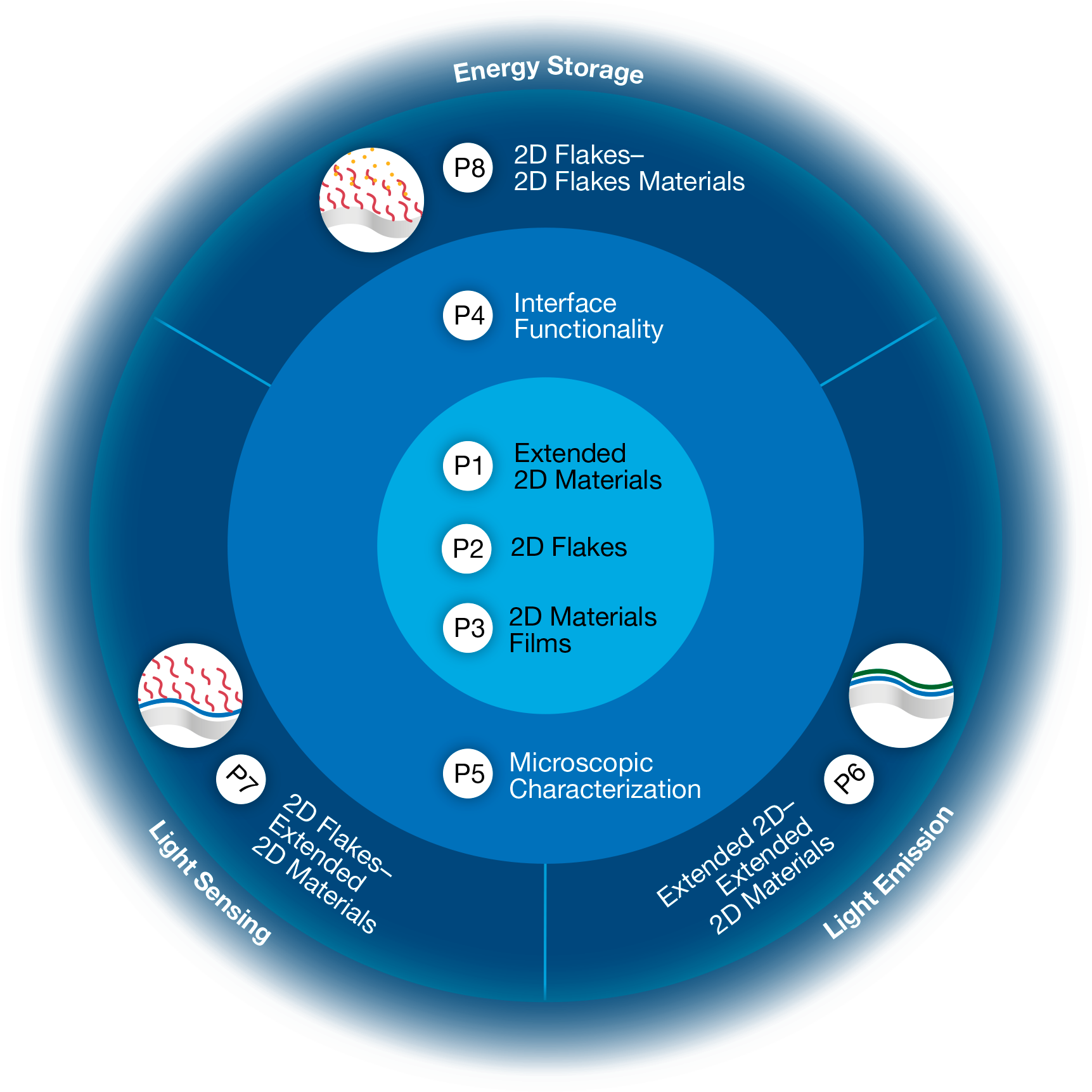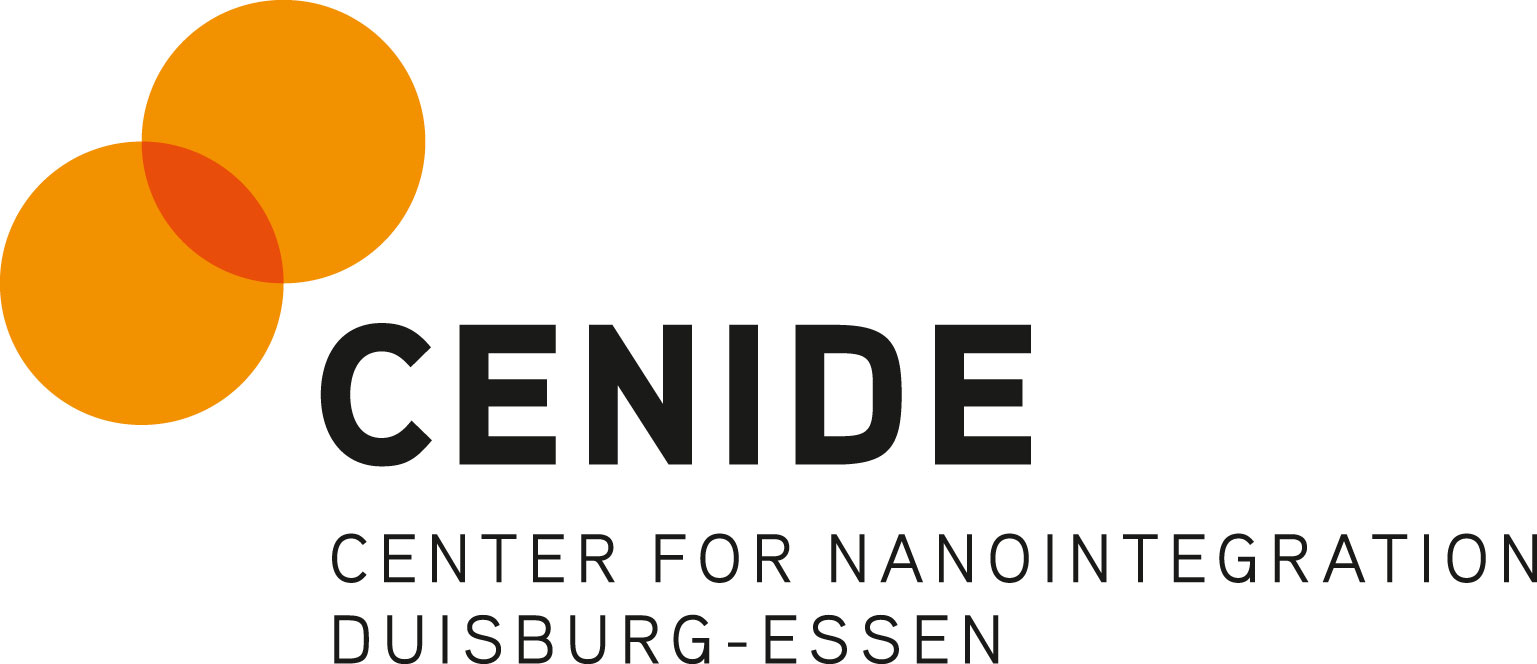Project Descriptions
Research activities in 2D-MATURE are organized in eight tightly interlinked projects P1–P8 with the intention to tackle the central scientific goal of the IRTG, namely overcoming the key barriers to commercialization of 2D materials, namely scalability in synthesis and processing and understanding interfacial phenomena in realistic device architectures.
The PhD candidates will be jointly supervised by two PIs with complementary scientific expertise, typically one from each country. All PhD projects are designed in a way that research is mainly performed at the home institution with an important contribution of research stays at the partner institution in the respective other country.

Heterostructures based on 2D materials have been implemented in various model systems, initially by transfer processes, and, more recently, by direct growth on a small scale. Hereby, different materials classes can be assembled without restrictions due to lattice mismatch. This leads to a highly flexible toolbox of 2D heterostructures and opens pathways to novel device concepts. However, upscaling of extended 2D-materials heterostructures with controlled interfaces is a timely topic not yet well explored. Being indispensable for practical relevance, wafer-scale growth techniques – like metal- organic chemical vapor deposition (MOCVD), plasma-enhanced chemical vapor deposition (PECVD) and spatial atomic layer deposition (SALD) – must be further developed and combined, and the underlying nucleation and growth mechanisms need to be understood. This is the goal of project P1.
PIs:
Prof. Dr. Gerd Bacher (UDE)
Prof. Dr. Kevin Musselman (UW)
Prof. Dr.-Ing. Andrei Vescan (RWTH)
PhD & MASc students:
Yingfang Ding (RWTH)
Poojitha Durgamahanti (UW)
Umut Kaya (UDE)
Vapor-phase synthesis of graphene and liquid-phase exfoliation of graphene and TMDCs are the most scalable production routes for substrate-free 2D-materials flakes. They have the potential to provide industrially relevant amounts of suitable quality materials for applications where functional but also flexible, strong, and electrochemically stable materials are needed, such as in batteries, supercapacitors, electrocatalysts, sensors or photodetectors. Challenges remain in terms of controlling the layer number, defect density, degree of functionalization, phase composition, and production yield, which impact their functionality at the device level. In project P2, we seek to systematically follow both gas- and liquid-phase reactions through a suite of in situ and ex situ diagnostics to identify critical steps or processes in the reaction systems which are required to achieve control over the abovementioned flake properties. The project aims to develop production routes with maximized yield and the ability to rationally tune properties based on process conditions.
PIs:
Prof. Dr. Kyle Daun (UW)
Prof. Dr. Michael Pope (UW)
Prof. Dr. Christof Schulz (UDE)
PhD and MASc students:
Sarah Jankhani (UW)
Ornel José Padilla Estrada (UDE)
Nicholas Wilson (UW)
Halil Ibrahim Yazici (UW)
2D materials flakes can be inexpensively synthesized in large volumes, and their diverse and unique properties make them promising building blocks for a range of applications. Their assembly into high-quality films is a necessary step for their device integration. Continuous, large-area deposition has been identified as a key requirement for cost-effective manufacturing. In tandem with the development of an appropriate coating method, properly formulated inks of 2D flakes are important to ensure stable, reproducible printing. Proper post-coating processing is necessary to improve inter-flake contact resistances. Lastly, many of the advantages of 2D flakes remain underexploited, particularly (i) their deposition on flexible substrates to permit cost-effective roll-to-roll printing and mechanically flexible devices, and (ii) their relative ease in forming layered heterostructures resulting in highly promising optoelectronic and electrochemical properties. Project P3 will develop a comprehensive approach to explore and solve these important issues that are necessary for the practical application of 2D materials flakes.
PIs:
Prof. Dr. William Wong (UW)
Prof. Dr. Doris Segets (UDE)
PhD and MASc students:
Lars Grebener (UDE)
Shaghayegh Pourdahrany (UW)
While the synthesis and functionalization of small quantities of high-quality 2D materials and their heterostructures under laboratory conditions, e.g., by mechanical exfoliation and stacking, is well developed, adapting these approaches to produce scalable 2D materials and to embed them into a functional architecture is more challenging since the processing environment and the resulting interfaces are less controlled and understood. Achieving this goal requires characterization and simulation techniques that can assess and predict the downstream functionality of these materials as well as their stability. The main objectives of P4 are to conceive and deploy the diagnostics essential to development and operation of scalable manufacturing techniques and to understand the functionality of the resulting real 2D-materials interfaces. The activities will concentrate on establishing structure–stacking–function relationships with focus on interface functionality and the role of the environment and developing techniques to facilitate translation of research focused on generating and functionalizing 2D materials to their implementation on showcase devices.
PIs:
Prof. Dr. Kyle Daun (UW)
Prof. Dr. Na Young Kim (UW)
Prof. Dr. Axel Lorke (UDE)
Prof. Dr. Rossitza Pentcheva (UDE)
Prof. Dr. Rodney Smith (UW)
PhD and MASc students:
Yasaman Jarrahi Zadeh (UDE)
Armin Sahinovic (UDE)
Jun Wang (UW)
Emily Yip (UW)
Jixi Zhang (UW)
Owing to their unique optical and electronic properties, convenient two-dimensional structure, and flexibility for device fabrication, 2D materials are being intensively studied. Most devices, however, do not perform as expected as even the slightest aberration from the ideal structure may affect the properties because of the 2D nature of the active layer. These imperfections are caused by, e.g., the interaction with the substrate or other 2D layers or by strain, point defects, dopants, and grain boundaries. In terms of performance, deviations from the ideal structure may be either detrimental or advantageous and the physical mechanisms of current strategies to either compensate or exploit these effects are only poorly understood. Project P5 aims to reveal the underlying microscopic mechanisms, on the base of which effective measures for fabrication and post-treatment compatible with scalability and device architecture are to be developed.
PIs:
Prof. Dr. Michael Horn-von Hoegen (UDE)
Prof. Dr. Peter Kratzer (UDE)
Prof. Dr. Marika Schleberger (UDE)
Prof. Dr. Germán Sciaini (UW)
PhD and MASc students:
Leon Daniel (UDE)
Marko Kriegel (UDE)
Dedi Sutarma (UDE)
Christian Viernes (UW)
Roufei Zheng (UW)
Due to their large oscillator strength and outstanding mechanical strength, 2D materials are attractive for light emitting devices, e.g., for curved or flexible architectures. As light emitting devices demand dominant bipolar or exciton recombination, the optically active 2D material must be embedded between suitable support layers for efficient and well-balanced charge injection. A van der Waal stack architecture that incorporates optically active 2D materials avoids restrictions due to crystal symmetry and lattice mismatch and thus presents an attractive pathway towards optoelectronic applications. Prototype devices realized so far have low brightness, limited scalability, and poorly controlled interfaces that lead to losses and/or injection barriers. To fully realize the potential of 2D materials for light emitting devices, scalable high-quality materials and architectures must be developed and optimized with respect to low injection barriers, efficient minority carrier blocking, optimized charge carrier balance, and minimized losses. This is the goal of P6.
PIs:
Prof. Dr. Gerd Bacher (UDE)
Prof. Dr. Na Young Kim (UW)
Prof. Dr. Kevin Musselman (UW)
Prof. Dr. Marika Schleberger (UDE)
PhD and MASc students:
Tobiloba Fabunmi (UDE)
Osamah Kharsah (UDE)
Ahmed Shahin (UW)
Denys Vidish (UW)
The growing interest in flexible electronics, e.g., for healthcare or environmental monitoring, optical communications, and wearables, generates a rising demand for flexible photodetectors. 2D materials provide a unique combination of optoelectronic and mechanical functionalities such as high oscillator strength, large in-plane charge carrier mobility, and mechanical flexibility and thus offer significant potential as active materials for next-generation flexible photodetectors. In project P7, various 2D materials are combined in hybrid van der Waals heterostructures beyond the constraints of lattice mismatching. Thisis expected to enhance photodetector performance, e.g., through decoration with semiconducting absorbers that can compensate for the inherently low light absorption in monolayer materials as compared to bulk semiconductors.
PIs:
Prof. Dr. Na Young Kim (UW)
Jun.-Prof. Dr. Franziska Muckel (UDE)
Prof. Dr. Michael Pope (UW)
PhD and MASc students:
Zhuoyang He (UW)
Jochen Konieczny (UDE)
Teri Siu (UW)
The use of 2D materials as an active or enabling component is of greatest interest in the field of electrochemical energy storage because it combines materials with a large surface area and at the same time low materials requirements, the ability to reversibly intercalate ions, high electrical conductivity, low percolation threshold, and great mechanical properties. While each 2D material has its own merits, heterostructures can yield improved functionality and device performance. However, simple, competitive, and scalable strategies to produce such heterostructures and to integrate them into energy storage showcase devices are still lacking. There is a need to controllably combine two functional materials into a heterostructure without the use of structure directing agents. Due to the additional dead weight and post processing steps such as annealing, both the capacity and the use of promising metastable phases may suffer and the application on flexible supports may be limited. Project P8 will address the challenges regarding the formation of 2D-materials based heterostructures, investigate their electrochemical properties from a viewpoint of energy storage applications, and implement them into practical showcase devices
PIs:
Prof. Dr. Michael Pope (UW)
apl. Prof. Dr. Hartmut Wiggers (UDE)
PhD and MASc students:
Ryan Zamperoni (UW)
Muhammad Ali (UDE)
Tianyu Liu (UW)
Casey Dudding (UW)
Yalin Wu (UW)



